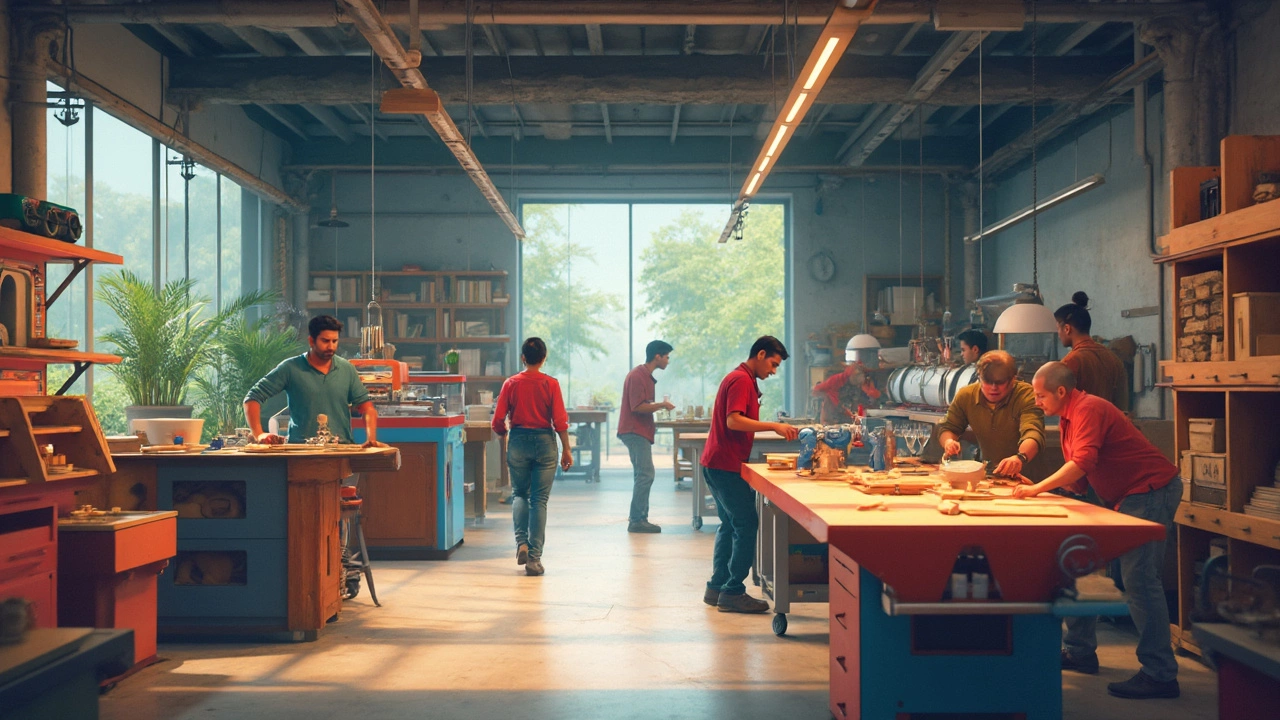
India's furniture industry, blending innovation and tradition, is gearing up for a significant boom in 2025. With a mix of smart policies and rising demand, it's like the stars are aligning for manufacturers. Imagine walking into a store where technology meets hand-crafted quality, offering products that fit modern lifestyles yet carry an age-old charm.
What’s pushing this growth? For starters, the government’s 'Make in India' initiative is a big deal. It's like a shot in the arm for local manufacturers, giving them the push they need to produce more and better. With tax breaks and support for local sourcing, it’s about making sure that homegrown products aren’t just available, but also competitive on the global stage.
- Rise of Local Manufacturing
- Technological Innovations in Production
- Changing Consumer Preferences
- Sustainability and Eco-Friendly Initiatives
Rise of Local Manufacturing
India is buzzing with energy as local manufacturing takes center stage in the furniture industry. Thanks to the 'Make in India' initiative, there's a strong push to produce not just more, but better. The goal? Make Indian furniture not only popular domestically but also globally competitive.
One driving force behind this shift is government support. By offering tax incentives and easing regulations, they've helped small and medium enterprises (SMEs) to play a larger role in the market. These SMEs are often nimble, able to adapt quickly to new technologies and design trends, making them crucial players in the manufacturing boom.
There's more to it than just policy support. Workforce skill development programs are sprouting up all over, turning local artisans into savvy professionals who can match the best in the world. This has a ripple effect, improving quality across the board and lifting the overall image of India's furniture industry.
| Year | Production Growth (%) |
|---|---|
| 2023 | 12% |
| 2024 | 15% |
| 2025 | 18% |
Finally, the growth in e-commerce has made it easier for local manufacturers to reach customers beyond their usual borders. With online platforms, even smaller companies are finding it easier to showcase their designs to a wider audience.
So, if you’re thinking about jumping into the furniture market in India, this is your year. The industry's ripe for innovation, and who knows, your design might just be the next big thing that everyone’s talking about.
Technological Innovations in Production
Technology is shaking up the furniture industry in India in a way that's hard to ignore. Think of it as a revolution that’s helping manufacturers churn out better and cooler stuff with less effort and waste.
Let’s jump into some specifics. One big player here is CNC (Computer Numerical Control) machining. This tech doesn’t just cut wood; it carves out super-detailed designs with pinpoint accuracy. It's like having a precision artist on your production line, ensuring consistency with every piece, whether it’s the legs of a sleek table or intricate carvings on a headboard.
3D printing is another game-changer. Now, it's not just about rapid prototyping but also creating fully functional furniture pieces. This tech allows manufacturers to test various designs without the hefty cost or time commitment of traditional methods.
And let’s not forget about AI and IoT (Internet of Things). These technologies help monitor and streamline the production process. Imagine machines that can talk to each other, predicting maintenance needs or adjusting processes in real-time to avoid material wastage.
Here's a quick overview of the impact of these technologies:
| Technology | Impact |
|---|---|
| CNC Machining | Enhances precision and reduces production errors |
| 3D Printing | Speeds up prototyping and enables custom designs |
| AI & IoT | Optimizes production processes and minimizes waste |
Such advancements not only improve quality but also cut costs in the long run, making it a win-win for both manufacturers and consumers. Plus, it positions Indian-made furniture as a formidable player in the global market—delivering both style and substance.

Changing Consumer Preferences
In 2025, the way people in India shop for furniture is shifting at lightning speed. It's not just about having a comfy chair anymore; people want their homes to reflect their personalities and the latest trends. This has furniture makers jumping, trying to keep up with what buyers want.
One major trend is the demand for customized furniture. People aren’t satisfied with cookie-cutter designs. They crave pieces that fit their unique style and space. Whether it's a modular sofa that can be rearranged in ten different ways or a dining table that doubles as a work desk, flexibility is key.
Technology also plays a massive role. Thanks to AR (Augmented Reality) tools, customers now can “see” how a piece of furniture looks in their living room before buying it. It's like test-driving a car but for your home. Customers love this feature as it reduces the buyer’s remorse that often follows big furniture purchases.
Environmentally-conscious choices continue to gain traction too. Shoppers are increasingly aware of where their furniture comes from and its environmental impact. This is driving demand for eco-friendly furniture, made from sustainable materials or using processes that leave a smaller carbon footprint. Terms like ‘reclaimed wood’ and ‘upcycled materials’ are not just buzzwords anymore – they are must-haves for the environmentally aware buyer.
Lastly, the influence of global design trends cannot be ignored. As more and more Indians travel and connect globally, there's a growing desire for designs inspired by international aesthetics, like the sleek lines of Scandinavian minimalism or the eclectic mix of bohemian designs.
In essence, the Indian furniture market is vibrant and evolving fast. Keeping up with these changing preferences is not just optional for manufacturers looking to stay relevant; it's necessary. For those who get it right, the rewards in 2025 could be huge.
Sustainability and Eco-Friendly Initiatives
In 2025, the furniture industry in India is making a major shift towards greener practices. Furniture manufacturers are not just thinking about style and function anymore—sustainability is becoming a key game-changer. Consumers are increasingly interested in the story behind the products they buy. They want to know if their chic new table or comfy sofa is being kind to the planet.
Several companies are now focusing on reducing their carbon footprints. This trend sees manufacturers opting for responsibly sourced materials and processes that significantly cut back waste. Bamboo, for example, is emerging as a favorite due to its rapid growth rate and minimal carbon impact. Gone are the days when sustainable meant sacrificing quality or design.
Creating furniture with minimal environmental damage isn't just a trend; it's a necessity. Furniture manufacturers in India are responding by innovating in areas like recycled materials and water-based adhesives, which are less toxic and better for the environment. It's all about doing more with less, and consumers dig it.
One striking collaboration is among manufacturers in Chennai, focusing on using fully recycled steel and reclaimed wood. This approach is not only eco-friendly but also remarkably cost-effective in the long run, setting a precedent for others. Smaller furniture makers are also stepping up, forming clusters to adopt best practices that meet international environmental standards.
| Eco-Friendly Material | Benefits |
|---|---|
| Bamboo | Fast-growing, strong, minimal carbon footprint |
| Recycled Steel | Reduces mining impact, 100% recyclable |
| Reclaimed Wood | Repurposes wood, reduces deforestation |
In the end, these initiatives are not just about preserving the environment but are also a smart business move. Building a reputation as an eco-conscious brand can attract a loyal customer base that's willing to pay a premium for sustainability. So, if you’re curious about what furniture to buy in 2025, it's worth looking at brands that boast both style and sustainability.